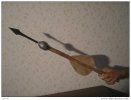waxing pedantic:
the aztecs called them "Tlacochtli", a rose by any other name.... have no idea why 'dart' is used you could call them 'freds' if you want, and someone else agrees to use it too... 'dart' is more descriptive if you engage in the great britiush pub sport. it's a name agreed on by users that has gained momentum, ... they are essentially a light javelin with fletching. a javelin is a light spear used for throwing. a spear is a pole-arm used for stabbing swordsmen who you do not want to get close. a pike is a long spear used in block formations or shiltrons, like the old greek phalanx. a sarissa is a long pike. a lance is a longish spear carried by horsemen.
the romans used heavy pilum (javelins or throwing spears) up until about the end of the second century a.d., then they used 'plumbatum', essentially a weighted lawn dart with a barbed point about 2 ft. long, the dart was weighted to hit harder with a blob of lead cast on the front. latin for lead is plumbum, hence the name, and as they used lead pipes, why we call our water transportation engineers 'plumbers'*. the early romans used a 7ft.-ish heavy spear called a 'hasta' for stabbing, then stopped carrying them in favour of the pilum and gladius. they did have them available if they were facing a lot of horsemen. used like pikes, rarely thrown.
plumbatum

note that is how they held them for throwing underhand for long range, the leather flights would straighten them out. modern athletes throwing the javelin found they could throw them much further by grasping near the butt end and spinning like a hammer thrower then releasing. went so far the method was outlawed, as are grooved javelin, streamlined shapes, special coatings, etc. because they want to keep the max range within the limits of the tracks so they don't accidentally skewer a runner.
for your range tests: idea: the flights help straighten the darts flight, but too big they add drag, try flights that are longer and shorter rather than taller to cut drag. then shorten them till you have the bare minimum fletching. two flights instead of three, the third is not needed at range.
*- roman 'plumbers' brought water into the houses of the rich and famous, the poor made do with community fountains. they were smart enough to use valves at the household end, to turn the water on/off. what we now call faucets or taps, spigots. they also used flush toilets, again the common people used communal toilets without stalls, with flowing water underneath to flush away waste so they could discuss business and gossip with the person eliminating next to you. no modesty at all. they even used pictures of erect male genetalia to point the way to the local brothels..

...and now for something completely different - sort of - the swiss arrow:
[video=youtube;uCyKrQDFA28]https://www.youtube.com/watch?v=uCyKrQDFA28[/video]


